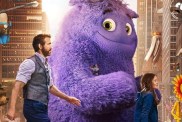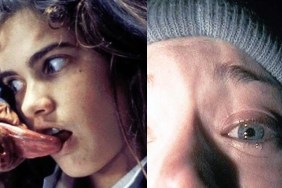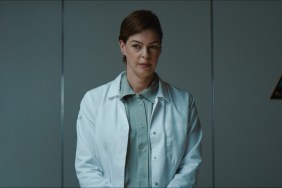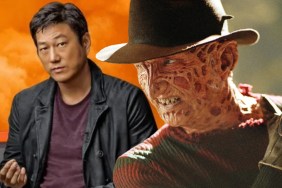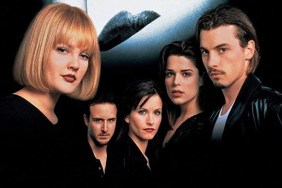
While watching The Lazarus Effect, it isnt difficult to think about a completely different movie, or several other completely different movies. Director David Gelbs filmthe latest inexpensively made and starry horror project from mega-producer Jason Blumoverflows with familiarity, a fact driven home in the majority of its reviews in which Flatliners and Pet Sematary are referenced without fail. The Lazarus Effect does have one thing going for it, and thats Olivia Wildes unhinged performance in the films third act, when her recently deceased character is brought back to life and starts offing every character in her path. Its in those scenes where Lazarus drums up thoughts of a third older horror film: Wes Cravens Deadly Friend.
The similarities are obvious. In both films, a grieving brainiac resurrects the love of his life using next-level smarts and scientific trickery. And in both cases, the results are bloody and corpse-ridden. The key difference, though, is that Deadly Friend isnt exactly paint-by-numbers. Cravens 1986 oddity is delightfully singularand, yes, also a total mess, a mangled product of studio interference thats earned a reputation as one of Mr. Nightmare on Elm Streets worst movies. Deadly Friend has been a stain on Cravens filmography ever since the $11 million-budgeted film bombed in early October 86, ultimately earning less than $9 mil at the box office. Sometimes though, it just takes a film like The Lazarus Effect to give you new found appreciation for one of cinemas most consistently lambasted misfires. Deadly Friend is bizarrely special, and categorically insane in the best possible ways.
Deadly Friends nightmarish pre-release saga definitely isnt one that Craven wishes to remember. A fan of author Diana Henstells sci-fi novel Friend, Craven hoped to faithfully channel the books tragic love story and character-focused drama, all with a dark science fiction underlining. At the time, it was a bold risk taken for him. He was coming off of the rightfully maligned sequel The Hills Have Eyes 2, a brick of a follow-up to his hugely successful 1984 instant classic A Nightmare on Elm Street. He needed to avenge himself, and he targeted the mainstream-ready, Warner Bros.-backed story of a tortured teen romance as his way of getting back on track. And he tried to do so by abandoning everything thatd made his prior films so popularnamely, graphic violence and the ensuing red stuff.
The man responsible for staging one of cinemas nastiest rape scenes in The Last House on the Left and hacking up teenagers in Elm Street wanted to drop the gore, get a PG rating, and change his direction. Sticking to the novels plot, Deadly Friend is the tale of a teenage tech whiz, Paul (played by Matthew Laborteaux) who falls in love with his new neighbor, Samantha (Kristy Swanson), and uses his knowledge of robotics to reanimate Sam after her abusive father accidentally kills her. The plan was to honor Henstells novel, which is devoid of viscera and heavy with subtext, a study in how terrible adults can ruin teens without even knowing it. In horror critic John Kenneth Muirs 2004 book Wes Craven: The Art of Horror, an archival interview with star Matthew Laborteaux outlines Cravens Deadly Friend goals: Wes said that the one thing he didnt want to do was make this a horror movie because its one of his first large-budgeted movies which isnt from New Line Cinema or Joe Blow Pictures That gave me a little sense of security knowing he wanted to do a nice picture.
Warner Bros., however, felt differently, and their antithetical views about the project only intensified once test-screening audiences had a look at Cravens initial Deadly Friend cut and demanded more Freddy Krueger-like horror. The studio forced Craven to add in ridiculous moments of high-concept carnage, including a dream sequence where blood sprays all over Sam after she impales her father with a broken lamp, and tack on a goofy final scene that makes absolutely no sense, and which undermines everything that precedes. Deadly Friend ends with a demonic robot head tearing through Samanthas facial flesh in a morgue, before killing Paul off-screen. It makes The Last House on the Left remakes microwave-centric coda seem like a Rod-Serling-quality ending by comparison.
When you watch Deadly Friend today, youre watching the version that Craven himself despises. Its a schizophrenic patchwork comprised of conflicting visions, unnecessary bloodshed, and more tonal shifts than Alex Ajas Horns. In a 1990 interview, Deadly Friend screenwriter Bruce Joel Rubin explained what exactly happened. The studio told me to give them six more scenes, each bloodier than the last That really destroyed our love story, and everyone blames me for the ending! That robot coming out of the girls head belongs solely to Mark Tapin, and you dont tell the president of Warner Bros. that his idea stinks!
But in that disaster remains one of the most entertainingly weird 80s horror moviesno small feat when you think back on the decade. When taken as a whole, Deadly Friends flaws congeal into a fascinating exhibition of a good director struggling to survive an inevitable trainwreck. The score, composed by Cravens A Nightmare on Elm Street collaborator Charles Bernstein, thrives on a melodramatic orchestral arrangement that sounds as if its been lifted straight out of Little House on the Prairie. The mean-spirited adult characters are overdrawn and overplayed to the point of hilaritySams father, in particular, is so heartless and evil that he might as well be painted red and have Lucifers horns sprouting from his forehead. The not-Johnny-5 robot that Pauls built for himself, named BB, babbles incoherently with a speech pattern that seems strangely influenced by the Tasmanian Devil. And when the microchip in Dead Sams brain turns her into a homicidal robo-zombie, Kristy Swanson waves bye-bye to subtlety with hilarious heavy-handed death stares and confuses menacing walk towards the victim for a silly combination of Karloffs Frankenstein and a break-dancer doing The Robot.
Deadly Friends apex is the wonderfully over-the-top kill thats been immortalized as the greatest horror movie GIF this side of the exploding head from Scanners. In a scene that isnt in Henstells novel and is clearly the byproduct of the studios mandate for crowd-pleasing money-shots, Sam gets revenge on the awful old woman across the street, Elvira (Anne Ramsey), by hurling a basketball at her face, the impact causing the elders skull to inexplicably become something comparable to a flesh-colored pumpkin thats been stuffed with a live grenade. And then, as blood flies out of the stub where her cranium just was, Elviras headless body keeps moving and wiggling around the room.

Its a cartoonish Looney Tunes moment injected with the spirit of Grand Guignol and made campy by cheesy special effects and makeup and it totally betrays the rest of Deadly Friend. Imagine watching Twilight and a comedic ABCs of Death short briefly disrupts the teen angst.
Knowing that Craven was required to splice in that delightfully idiotic, gruesome scene via reshoots, one wouldnt be wrong in picturing the director figuratively giving Warner Bros. the middle finger while shooting what would become horrors greatest NBA crossover moment. Or arriving on set that day and saying, They wanted blood, right?
Deadly Friends brand of fascinating, anger-fueled, and intentionally wacky filmmaking will always trump bland, risk-free films like The Lazarus Effect. Thats certainly not the reaction that Wes Craven originally desired, but its the one that his wrongfully labeled worst movie ever deserves.
—
Matt Barone is a film-obsessed writer who, when hes not contributing to outlets like Complex, The Dissolve, and Badass Digest, endlessly weighs in on all things horror on Twitter.


